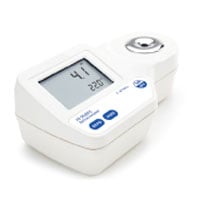
Sugar cane (Saccharum Officinarum) is a type of tall grass that is fertile in alluvial or red soil, and is popular for cultivation worldwide for the production of sugar.
It is used both as a cash crop as well as an alternative energy source. Among the various products which we use sugarcane for, the preparation of cane sugar is the most common.
A sugar manufacturer must follow stringent rules that are outlined by the International Commission for Uniform Methods of Sugar Analysis (ICUMSA) in order to remain successful in the industry.
% Brix of Sugarcane
Among the various analytical methods required in cane sugar production, analysis of Brix percentage of sugarcane juice is one of the most important parameters.
The Brix percentage is a measure of the sucrose, or sugar content. One degree Brix is equal to one gram of sucrose in 100 grams of solution. This means that a solution that's 20% Brix is equal to 20% sucrose.
The amount of sucrose depends on many factors, such as temperature, altitude, soil fertility, climate, and yield management. Higher sugar content in the base sugarcane juice leads to a higher yield of finished sugar.
Different types of sugarcane can differ greatly in their sucrose levels; sucrose content can vary from 15% Brix to 23% Brix. Sugarcane with a Brix percentage closer to 23% Brix is considered to produce the highest quality of cane sugar.
After harvesting the sugarcane stems, the manufacturing process begins with extraction of the cane juice. The sugarcane stems are crushed in a series of mills which squeeze out the juice and separate the cane fibers. The cane juice is filtered and evaporated to produce a thicker, syrup-like product, to which sulfur is added for coloration and increased shelf life. The thickened cane juice is then boiled to promote the growth of sugar crystals, which are then separated by centrifugation. The pure sugar are finally dried prior to packaging and final storage.
Using a Refractometer for Sugar Analysis
Typically, Brix is determined by refractive index. When dissolved solids such as sugar increase, the refractive index increases. This allows us to use refractometers to measure a variety of different compounds. Refractometers work particularly well on sugarcane since virtually all of the dissolved solids in the juice are sucrose.
All refractometers work by determining the refractive index of the sample. We can then convert the refractive index using calculations or scales. Digital refractometers do this conversion for you, and give a simple Using a digital refractometer is easy and just involves a few simple steps:
- Place deionized or distilled water on the sample well. You'll only need about 100 uL for full coverage of the prism.
- Press the Zero button.
- Remove the water from the prism.
- Place your sample on the sample well.
- Take the refractometer reading.
- Clean the prism and repeat for any other measurements
Hanna Tip: If you're measuring samples that are very hot or very cold, allow time for the internal temperature sensor in the meter to stabilize for an accurate reading.
The low sample size and ease of use makes these meters ideal for using a refractometer on the production line. The whole process from zeroing to measurement takes just a few seconds.
Hanna Helps Measure Sugar Content
A customer from a sugar manufacturing unit consulted with Hanna about measuring sugar content in their sugar cane. We offered them the
Hanna HI96801 Digital Refractometer for Sugar Analysis.
The range of the meter is 0 to 85% Brix, which was suitable as the customer was looking to measure in the range of 20 to 23% Brix.
The digital refractometer was a great option for the customer; it not only offers a high accuracy of ±0.2% Brix but also reduces potential errors with temperature variations associated with mechanical refractometers. This way, any potentially hot sugarcane juice can be measured accurately with the assistance of internal temperature compensation.
The rugged portability and ease-of-use were greatly appreciated by the customer, as any of their operators could easily analyze samples without the need for technical guidance.
The HI96801 comes with a dual-level LCD display to show users the % Brix as well as the temperature of the sample. All readings are automatically compensated according to the tables found in the ICUMSA method book for sucrose refractive index.
The customer greatly valued the 1.5-second response time of the HI96801 which allowed for quick and accurate checks at different stages in their production process.



